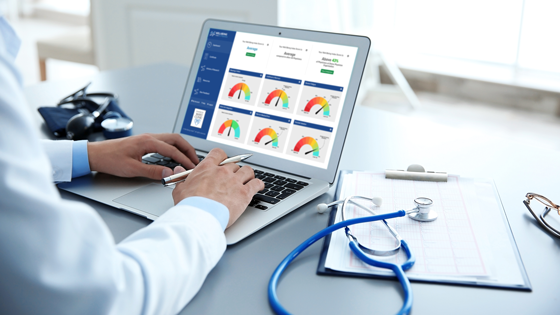
In order for organizations to reduce distress and improve well-being, it's necessary to be able to collect accurate and meaningful data on their current state. Psychological distress and well-being may seem like ambiguous concepts that are impossible to quantify, but that is not the case. Through years of research and a rigorous multi-step validation process, the Well-Being Index was invented by physicians at Mayo Clinic to accurately measure six dimensions of distress and well-being. Since then, the Well-Being Index has been validated by various publications and used by over 600 medical institutions and organizations worldwide.
The need for a validated assessment in combating distress is indispensable, but that's not all that the Well-Being Index provides. Along with the data, the Well-Being Index puts intuitive tools in the hands of participants and administrators that assist in systematically reducing distress. With detailed data segmenting, national and internal benchmarking, resource access reporting, and participant feedback functionalities, the Well-Being Index is the all-in-one tool that equips organizations with everything they need to Go Beyond Burnout.
Specialty and Departmental Segmenting
Arguably the most important aspect of the Well-Being Index is the ability to segment the data that is collected. Once the assessment has been launched and completed by participants, organizational administrators will be able to segment data by a number of different factors.
By default, the Well-Being Index provides reports on the percentage of individuals with a high level of distress, mean score by gender, specialty, and years since graduation. Administrators can examine the results with specialty and departmental segmenting to further understand what is happening inside the organization and identify the groups most in need of support. They can then use this data to plan strategic interventions and measure the effectiveness of wellness initiatives with future rounds of assessments.
[RELATED: The Current State of Nurse Well-Being in the US]
National and Internal Benchmarking
The vast amount of Well-Being Index data collected from over 120,000 assessments allows for benchmarking capabilities for both the administrators and participants. National benchmarking allows administrators to compare the organization's well-being scores with those of other institutions throughout the United States. In addition, participants can use national and internal benchmarking to see how their results compare to their peers' and national averages. This ability promotes self-awareness and allows organizations to further evaluate their wellness programming.
[RELATED: 6 Dimensions of Distress and Well-Being]
Resource Access Reporting
Once a participant completes their assessment, the Well-Being Index then provides them with immediate access to a variety of custom resources based on their results. National resource categories include Stress & Resiliency, Money, Relationships & Work-Life Integration, Alcohol/Substance Abuse, and many more. Organizations can also input their own custom, local resources. Along with the segmenting and benchmarking, the Well-Being Index offers resource access reporting, in which administrators can see which resources are being used most frequently by their providers. This valuable insight can be used to provide even more support in the necessary areas.
Participant Feedback
In addition to the detailed data-analysis functionalities, the Well-Being Index also allows organizations to ask participants long-form-response process improvement questions immediately following the 9 questions of the assessment. These responses remain completely anonymous and provides participants with the opportunity to give honest feedback and suggestions on what steps the institution can take to improve conditions and reduce stress. Organizations have the ability to tag and categorize responses to uncover similarities to better understand what their staff is wanting or thinking.
As one of the most impactful aspects of the Well-Being Index, participant feedback via process improvement questions allows wellness leadership to get a pulse on the organization and participants to be heard on a platform where they feel comfortable.
Use Data, Not Guesses
The unparalleled functionalities of the Well-Being Index allow healthcare institutions to enact strategic changes to improve well-being based on accurate data gathered with a clinically-validated tool. Dive deeper into the well-being of your organization than ever before while maintaining complete participant anonymity. The Well-Being Index equips your organization with the data and tools needed to Go Beyond Burnout.

 The Well-Being Index team is made up of thought leaders, healthcare associates, technology experts, and content creators dedicated to improving well-being by equipping organizations with the tools and data needed to Go Beyond Burnout.
The Well-Being Index team is made up of thought leaders, healthcare associates, technology experts, and content creators dedicated to improving well-being by equipping organizations with the tools and data needed to Go Beyond Burnout.

